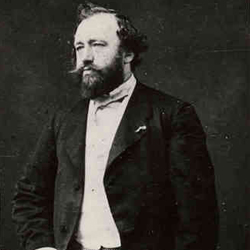In the Beginning

The saxophone (also referred to informally as the sax) is a conical-bore, transposing musical instrument that is a member of the woodwind family. Saxophones are usually made of brass and played with a single-reed mouthpiece similar to that of the clarinet. The saxophone was invented by the Belgian instrument maker Adolphe Sax in 1846. He wanted to create an instrument that would be the most powerful and vocal of the woodwinds, and the most adaptive of the brass—that would fill the vacant middle ground between the two sections. He based his design on the Ophicleide, an obsolete orchestral instrument which had keys like on a saxophone but used a cup mouthpiece like a brass instrument, and looked like a large Euphonium. He patented the saxophone on June 24, 1846 in two groups of seven instruments each. Each series consisted of instruments of various sizes in alternating transposition. The series pitched in B♭ and E♭, designed for military bands, has proved extremely popular and most saxophones encountered today are from this series. Instruments from the so-called "orchestral" series pitched in C and F never gained a foothold, and the B♭ and E♭ instruments have now replaced the C and F instruments in classical music. While proving very popular in military band music, the saxophone is most commonly associated with jazz and classical music. There is substantial repertoire of concert music in the classical idiom for the members of the saxophone family. Saxophone players are called saxophonists.

The saxophone was developed in 1846 by Adolphe Sax, a Belgian-born instrument maker, flautist, and clarinetist working in Paris. While still working at his father's instrument shop in Brussels, Sax began developing an instrument with the projection of a brass instrument and the agility of a woodwind. He wanted it to overblow at the octave, unlike the clarinet, which rises in pitch by a twelfth when overblown. An instrument that overblew at the octave would have identical fingering for both registers.
Prior to his work on the saxophone, Sax had made several improvements to the bass clarinet by improving its keywork and acoustics and extending its lower range. Sax was also a maker of the then-popular ophicleide, a large conical brass instrument in the bass register with keys similar to a woodwind instrument. His experience with these two instruments allowed him to develop the skills and technologies needed to make the first saxophones. Adolphe Sax created an instrument with a single reed mouthpiece like a clarinet, conical brass body like an ophicleide, and the acoustic properties of both the French horn and the clarinet.
Having constructed saxophones in several sizes in the early 1840s, Sax applied for, and received, a 15-year patent for the instrument on June 28, 1846. The patent encompassed 14 versions of the fundamental design, split into two categories of seven instruments each and ranging from sopranino to contrabass. Although the instruments transposed at either F or C have been considered "orchestral", there is no evidence that Sax intended this. As only 3 percent of Sax's surviving production were pitched in F and C, and as contemporary composers used the E♭ alto and B♭ bass saxophone freely in orchestral music, it is almost certain that Sax experimented to find the most suitable keys for these instruments, settling upon instruments alternating between E♭ and B♭ rather than those pitched in F and C, for reasons of tone and economy (the saxophones were the most expensive wind instruments of their day). The C soprano saxophone was the only instrument to sound at concert pitch. All the instruments were given an initial written range from the B below the treble staff to the F, one space above the three ledger lines above staff, giving each saxophone a range of two and a half octaves.
Sax's patent expired in 1866; thereafter numerous saxophonists and instrument manufacturers implemented their own improvements to the design and keywork. The first substantial modification was by a French manufacturer who extended the bell slightly and added an extra key to extend the range downwards by one semitone to B♭. It is suspected that Sax himself may have attempted this modification. This extension is now commonplace in almost all modern designs, along with other minor changes such as added keys for alternate fingerings.
Sax's original keywork, which was based on the Triebert system 3 oboe for the left hand and the Boehm clarinet for the right, was very simplistic and made playing some legato passages and wide intervals extremely difficult to finger, so numerous developers added extra keys and alternate fingerings to make chromatic playing less difficult. While the early saxophone had two separate octave vents to assist in the playing of the upper registers just as modern instruments do, players of Sax's original design had to operate these via two separate octave keys operated by the left thumb. A substantial advancement in saxophone keywork was the development of a method by which the left thumb operates both tone holes with a single octave key, which is now universal on modern saxophones. One of the most radical, however temporary, revisions of saxophone keywork was made in the 1950s by M. Houvenaghel of Paris, who completely redeveloped the mechanics of the system to allow a number of notes (C♯, B, A, G, F and E♭) to be flattened by a semitone simply by lowering the right middle finger. This enables a chromatic scale to be played over two octaves simply by playing the diatonic scale combined with alternately raising and lowering this one digit. However, this keywork never gained much popularity, and is no longer in use.

The primary (military band) saxophone family alternates instruments in B♭ and E♭. The other (orchestral) family patented by Sax, alternating instruments in C and F, has always been marginal, although some manufacturers tried to popularise the soprano in C (or C soprano saxophone), the alto in F (or mezzo-soprano saxophone), and the tenor in C (or C melody saxophone) early in the twentieth century. The C melody enjoyed some success in the late 1920s and early 1930s as a parlor instrument. One company has recently revived production of the C soprano and C melody. Instruments in F are rare.
Parts of the Saxophone
Neck - Also called the "gooseneck," it is a metal tube that is attached to the body of the saxophone. It is removable except for a soprano saxophone.
Octave Vent and Key - The octave vent is a single hole and key located on the neck of the saxophone. Next to that is a flat metal key called the octave key.
Mouthpiece - Is found on the neck of the saxophone. A cork is needed so that the mouthpiece can slide in. As you may already know, this is where the musician places his lips and blows air into the instrument to produce sound.
Body - It is a conically shaped brass tube that has plates attached to it and holds the rods, keys and other parts of the saxophone. The straight part of the body is called the tube. The u-shaped bottom of the sax is called the bow. The flared part of the sax is called the bell. The keys on the bell are called bell keys. The body usually has a high-gloss brass lacquer or clear-coat lacquer finish. Some saxophones are either nickel, silver or gold plated
Thumb Rest - It is a hook-shaped piece of plastic or metal where you place your right thumb to support the sax.

Keys - May either be made of brass or nickel and often some or all of the keys are covered with mother-of-pearls. The keys on the middle and lower part of the bow are called spatula keys. The keys on the bottom right side are called side keys.
Rods - This is one of the most important part of the saxophone in terms of its performance. That's why it is very important that the rods be strong and well maintained.
Pads - It covers the holes of the saxophone enabling it to produce different sounds. The pads must completely cover the tone holes. They also have a resonator to help in sound projection.

